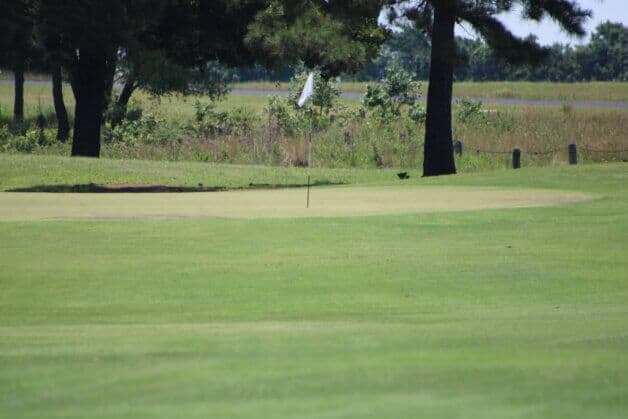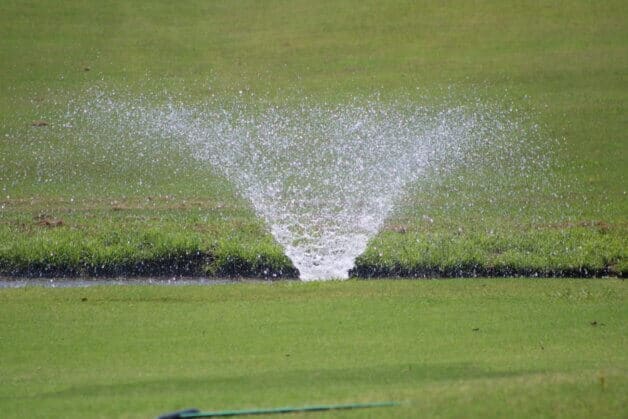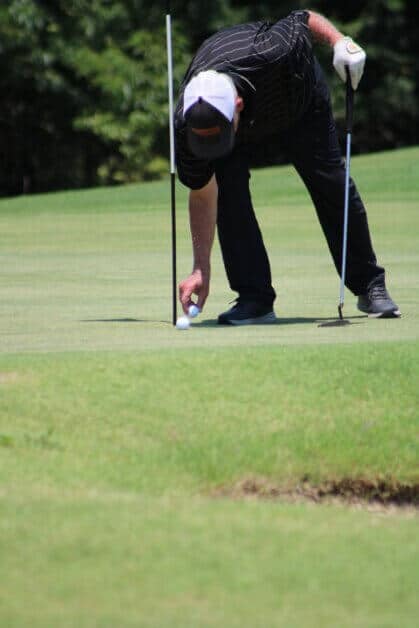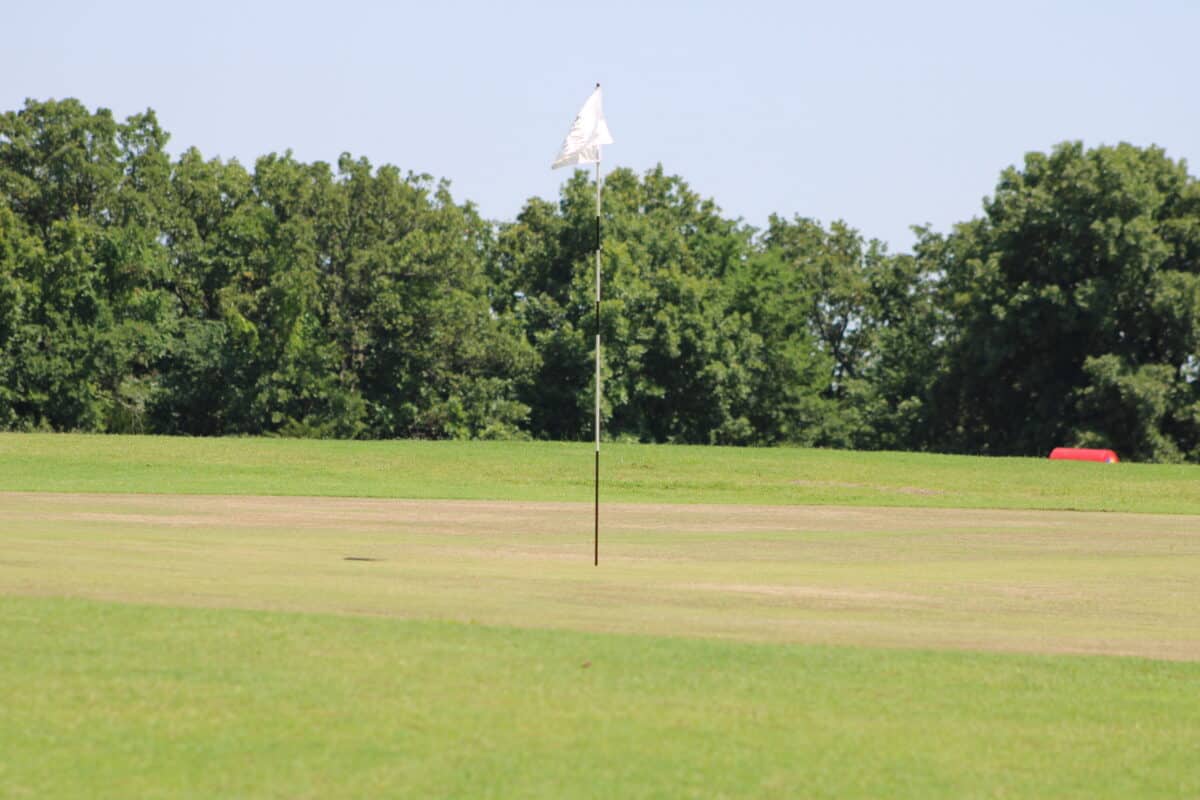The most frequently asked and perhaps the most answered question among golfers is ‘how to aim in golf?’ But, many of the popular golf swing and equipment tips are not right. The advice shared at the 19th hole and the tee tees tend to do more harm than good.
Aiming at the target is no exception. But, where do you aim on a golf ball? The confusion about how to aim usually causes golfers to miss their target. This article shares with you some important tips on how to aim your golf shot correctly.
Hitting the right shots that reach where you have set your goal is the game’s objective, but it is not always something easy to achieve. The first step to achieve this is to have a good technique when aiming because naturally, you will hardly be able to reach a goal that you are not aiming at correctly.
Therefore, make sure not to miss out on any information about how to aim correctly in golf. Read on!
The Stance or Position in Golf: How to Aim Correctly
Perhaps the first question that comes to mind when you hit a golf ball is: How do I position myself? This is not a trivial question since it will depend on the correct positioning of your body that you achieve the right balance to execute the swing with the greatest control and strength and a proper alignment concerning the target.
According to pro golfers, most of the missed shots are due to a wrong position. Let’s go by parts:
Respect the Target Line
You stand behind the ball, visualize the stroke you want to hit, and determine the goal line. Setting an intermediate goal a few meters from the ball and in line with the final goal is advisable. It can be an old chop, a clearing in the grass, a piece of the tee, etc., anything when it comes to squaring the clubface and aligning yourself with ease.
An Essential Tip for Aiming the Club Face
One of the most common questions is how to aim golf club Face. An essential tip is to hold the club with only the right hand and approach the ball from behind. You look above and below the line that runs from the ball to the target.
It means looking for a point a few meters in front of the ball on that line. When you find it, place the clubface behind the ball, and wedge it in until it’s pointed directly at that little target.

After determining the objective, you have to aim with the club’s face and then with the feet, knees, hips, and shoulders parallel to this line (or slightly pointing to the left). Let’s visualize this step:
The analogy of a player standing on the rail of a train track is usually used, where feet, knees, hips, and shoulders follow the direction of that track, and a ball placed on the other track pointing directly at the target.
One thing should be clear that when forming the grip, the right hand is placed lower than the left (for a right-handed player), with which there is a slight inclination, placing the left shoulder a little higher than the right.
The separation of the feet should be approximately the same as the shoulders’ width when playing 5 or 6 irons. With more open clubs, the tendency is to bring the feet a little closer (almost together with a wedge) and, on the contrary, in the case of the most closed (woods and drive), the separation will be progressively greater.
Golf Game Ball Position
First Theory
First, you must always place the ball in front of the inside of the left foot’s heel. In this way, you will have to change the position of the right foot according to the club you will play. This method is used by Jack Nicklaus, as he well explains in his book Golf My Way. It has also apparently been used by other great players, and several recent instructors advise this method.

Second Theory
Some criticize the first theory, saying that the ball’s position is the most important thing after the grip. They disagree that you must play the ball in front of the left heel on all strokes. Good players can, as long as the ball is well placed on the grass.
But if you play a 9-iron with the ball in front of your left heel, you’re going to have to do a high-speed hip roll to hit the ball before the club reaches its lowest point in your swing. The only strokes you must play with the ball in front of the left heel are the drive and wood with the ball on a tee. With the rest of the clubs, you must delay the ball one centimeter at a time until it is placed in front of your feet’s center.
Hence, the ball is placed in the center of the feet for wedges and short irons. It progressively moves forward in the longer irons (from 6) until it reaches the drive, where you must locate the ball at the height of the inside of the left foot. Tiger Woods is one of the supporters of this second theory.
As always, it is convenient to experiment and be advised by a professional.
What should be The Position of Your Feet?
Regarding the position of the feet on the ground, the right foot should be at a right angle to the shooting line, and the left foot will be slightly open towards the target (turned to the left).
The latter can prevent the backswing from being excessive (causing an exaggerated displacement) and, at the same time, facilitate downswing, passing through the ball quickly and with force; but, this is not a fixed rule.
Some experts point out that your feet’ position does not affect the point of the ground on which the club will rest, but it is very important in the length of the swing. The amateur player may prefer to also open the right foot a little to allow a greater turn.
The knees should be bent (just a little), adopting a semi-sitting posture, as if you were to lean on a high chair. The weight will be distributed evenly on the soles (between the heel and the ball of each foot).
In turn, the back leans towards the ball from the hips, keeping it as straight as possible but comfortably and pulling the buttocks out a little. In this position, the arms should fall from the shoulders comfortably, without tension; the left straight but not rigid, and open the right foot elbow.
How To Aim In Golf: What Determines Your Placement?
Your placement will be determined, fundamentally, by:
a) The Lie Angle
When placing the club behind the ball with the right hand, you must maintain the opening corresponding to it and correctly support the face on the ground. With longer clubs, such as the drive, the hands will be located a little further from your body, although you do not incorporate more from the ground; you bend a little more forward with the short sticks.
b) The Height of the Player
In general, taller players have to bend more at the waist and position themselves a little closer to the ball (taking a more vertical swing). The shorter players tend to lean less on the ball, remaining somewhat further away (swinging slightly flatter).
The chin must be kept raised away from the chest to favor the correct rotation of the shoulders. And in that position, the head will remain relatively still because all great players move their heads slightly back, before and during impact, but never forward.
Finally, remember that the position has to be solid, and always consult with a teacher on how to adapt your position (and swing) to your height and age.

How Can I Improve My Aim in Golf?
Confusion about how to aim usually causes golfers to miss their target in two ways:
• The first is by pointing the feet, knees, hips, and shoulders directly at the target, leaving the clubface directed towards a line well to the right of the target. This usually results in a swing motion coming from above and a hit near the club’s tip. It is no surprise, then, that those who misalign their body and clubface this way miss the target to the right unless they adjust their swing to get the ball back on the line.
• The second misalignment error results in adjustments to errors in the flight of the ball. For example, a player who hits “slice” points to the left to favor the ball’s flight from left to right, and the error causing the “slice” is not corrected.
When aiming correctly, the leading edge of your club is at a right angle to the goal line, while your body is aligned parallel to the left of the goal line.
Only the practice of this technique will give you the habit of aligning yourself correctly on the court. At the driving range, you choose a goal and put a stick a few centimeters in front of the ball, parallel to the goal line. Let’s place another stick parallel to the first one on the foot line to indicate your body alignment. After a few strokes, you can train your body and eyes to accept this new alignment compensation.
Your Intermediate Target is the Ball, Not the Flag
A high-level player who dedicates himself to practicing his swing obtains good results. During training, everything goes well; they can control their swing direction and clubface and play very well at the practice. Then as the day of the tournament arrives closer, the same player faces new difficulties because he wasn’t thinking of anything except the target. The analogy made to them is that of a basketball player who only looks at the basket. Because they are high-performance high-level athletes, they will automatically and inevitably obtain a feel, a “sensation” for the shot. Play and no longer need to aim, look at the flag/basket, and let go.
The greatest tip of all times is never to look at the target. The target is on the ground in front of you, the ball. Unfortunately, by focusing exclusively on the flag and not thinking about anything, the player’s internal mechanism realizes that they have not oriented well. Their club path changes suddenly, and they do not change the orientation of that clubface to go with the change in swing direction.
You have to aim with the club, and it is not an automatic mechanism. Everyone has to line up correctly with both the body and the clubface to throw the ball in the desired way while paying close attention. Once you understand this procedure, you will improve your aim.
But, what does this mean in practice? Tour golfers with caddies must be familiar with a hole on their course that scares them, a wind that shatters them, a departure that is oriented strangely, or any unpleasant situation. All of these things can start to influence your swing direction. The left-right wind for a right-handed person, for example, will often cause the golfer to execute an ext/int movement to try and start the ball further to the left, often resulting in a disaster.
On the other hand, if you start behind the ball and find an intermediate point to aim at, you are well aligned, and you have a systematic procedure in place (for example, you draw an arc of a circle around a fixed point). In this way, you do not let other factors influence you.
Note that the goal largely depends on fitness. Players with a low handicap can aim towards the flag because they are more precise. In the case of a medium handicap, it will be more convenient to direct the ball to the center of the green, while high handicap players should seek a wider margin and aim for the back of the green.
Conclusion
We hope this article has answered the question, ‘how to aim in golf?’ Remember that aligning your clubface and your body parallel to the line of play will allow you to aim more easily, identify your distance from the ball, and position the ball better with your feet. And, do not forget to share this information with other golfers you play this.
- Should Tee Boxes Be Level? - January 23, 2024
- 3 Hybrid Distance - November 15, 2023
- Innovations in Golf Mobility: An In-depth Review of Top Golf Scooters - October 12, 2023
